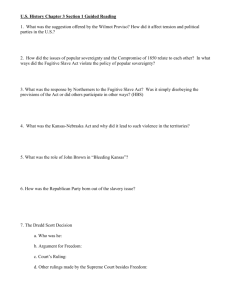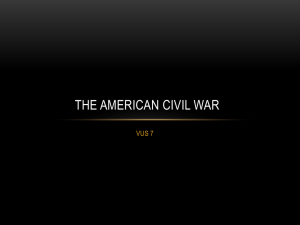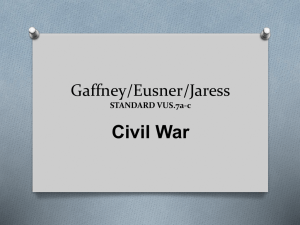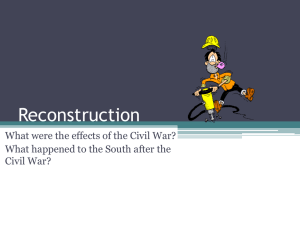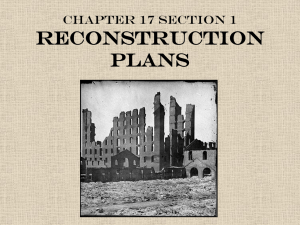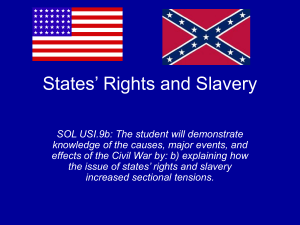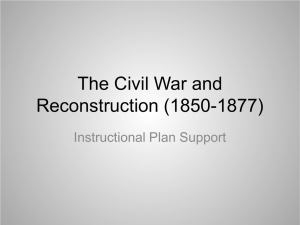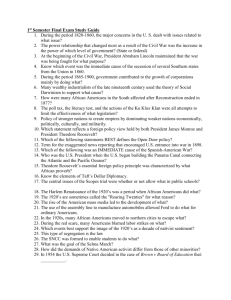Summarization of Civil War and Reconstruction 2013
advertisement
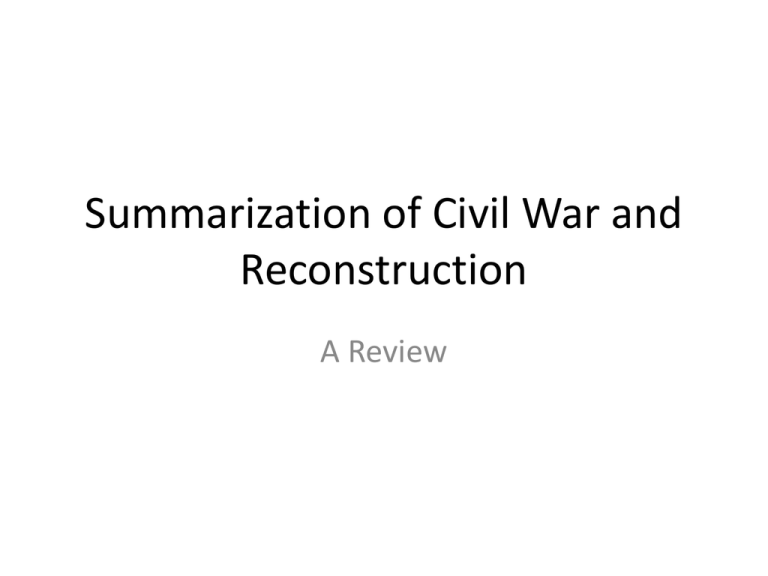
Summarization of Civil War and Reconstruction A Review Causes of the Civil War • Sectional disagreements and debates over tariffs, extension of slavery into the territories, and the nature of the Union (states’ rights) • Northern Abolitionists versus Southern defenders of slavery • Supreme Court decision in the Dred Scott case • Publication of Uncle Tom’s Cabin by Harriet Beecher Stowe Causes of the Civil War • A series of failed compromises over the expansion of slavery in the territories • President Lincoln’s call for federal troops in 1861 Major Events of the Civil War • Election of Lincoln (1860), followed by the secession of several Southern states that feared Lincoln would try to abolish slavery • Fort Sumter: Opening confrontation of the Civil War • Emancipation Proclamation issued after the Battle of Antietam • Battle of Gettysburg: Turning point of the Civil War • Appomattox: Site of Lee’s surrender to Grant Key Leaders of the Civil War • Abraham Lincoln: President of the United States (Union) during the Civil War, insisted that the Union be held together by force, if necessary • Jefferson Davis: U.S. senator; became president of the Confederate States of America (Confederacy) Key Leaders of the Civil War • Ulysses S. Grant: Union military commander; won victories over the South after several other Union commanders had failed • Robert E. Lee: Confederate general of the Army of Northern Virginia; opposed secession, but did not believe the Union should be held together by force; urged Southerners to accept defeat and unite as Americans again, when some Southerners wanted to fight on after Appomattox Key Leaders of the Civil War • Frederick Douglass: Former enslaved African American; became a prominent abolitionist and urged Lincoln to recruit former enslaved African Americans to fight in the Union army Emancipation Proclamation • Freed those slaves located in the “rebelling” states (Southern states that had seceded) – Lincoln wanted to keep the slave holding border states happy and prove that he supported the Constitution which said that slavery was legal. • Made the abolition of slavery a Northern war aim – once he freed the slaves in the rebelling states the North was no longer fighting to keep the Union together but to free men from bondage. Emancipation Proclamation • Discouraged any interference of foreign governments – if a foreign country sided with the South they would be saying that they agreed with the institution of slavery. • Allowed for the enlistment of African American soldiers in the Union Army – once they were freed any African Americans who made it to the North could enlist in the army just like all free whites Gettysburg Address (p. 1180) • Lincoln’s Gettysburg Address said the United States was one nation, not a federation of independent states. • For Lincoln, the Civil War was about preserving the Union as a nation “of the people, by the people, and for the people.” • Lincoln believed the Civil War was fought to fulfill the promise of the Declaration of Independence and was a “Second American Revolution.” Gettysburg Address • Lincoln described the Civil War as a struggle to preserve a nation that was dedicated to the proposition that “all men are created equal” and that was ruled by a government “of the people, by the people, and for the people.” • He believed America was “one nation,” not a collection of sovereign states. • Southerners believed that states had freely joined the Union and could freely leave. Impact of Civil War and Reconstruction • Lincoln’s view of one indivisible nation had prevailed. • Lincoln believed secession was illegal, Confederate governments in the Southern states were illegitimate and the states had never really left the Union. • He believed that Reconstruction was a matter of quickly restoring legitimate Southern state governments that were loyal to the Union. Impact of Civil War and Reconstruction • Lincoln believed that to reunify the nation, the federal government should not punish the South, but act “with malice towards none, with charity for all…to bind up the nation’s wounds…” (2nd inaugural address)p.1181 • Lincoln’s assassination allowed Radical Republicans to influence Reconstruction to make it harsher on the South. Radical Republicans • The Radical Republicans were not only harsher toward Southerners, but they believed in aggressively guaranteeing voting and other civil rights to African Americans. • The Radical Republicans eventually impeached Andrew Johnson, but failed to remove him from office by one vote. The Civil War Amendments • 13th Amendment: Slavery was abolished permanently in the United States • 14th Amendment: States were prohibited from denying equal rights under the law to any American • 15th Amendment: Voting rights were guaranteed regardless of “race, color, or previous condition of servitude” (former slaves) Compromise of 1877 • Reconstruction ended following the presidential election of 1876 • In return for support from Southern Democrats in the electoral college vote, Republicans agreed to end military occupation of the South. • Known as the Compromise of 1877, this enabled former Confederates who controlled the Democratic Party to regain power. Compromise of 1877 • It opened the door to the “Jim Crow Era” and began a long period in which African Americans in the South were denied the full rights of American citizenship. Economic Impact of War and Reconstruction • Southern states were devastated and bitter by the war. • The South had been destroyed and Confederate money was worthless. • Many towns lay in ruin and the source of labor was changed due to the loss of life during the war and the end of slavery. • The South remained an agricultural-based economy and the poorest section of the nation for many decades afterward. Economic Impact of War and Reconstruction • The North and Midwest emerged with strong and growing industrial economies, laying the foundation for industrialization of the nation in the next half-century and the emergence of the United States as a global economic power by the beginning of the twentieth century. • The completion of the Transcontinental Railroad soon after the war, intensified westward movement of settlers into the states between the Mississippi River and the Pacific Ocean.
